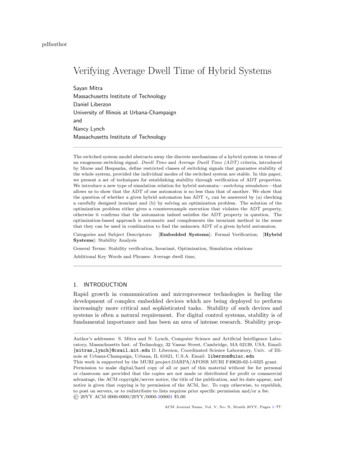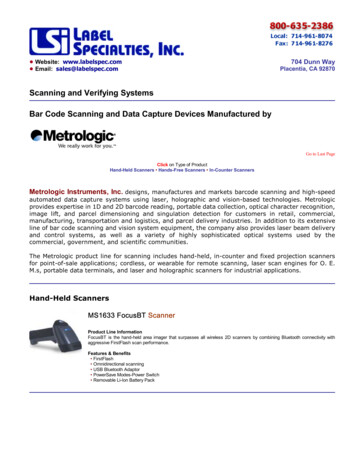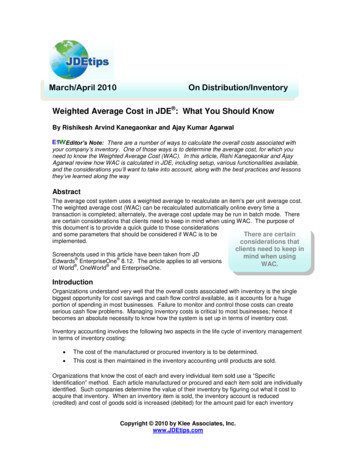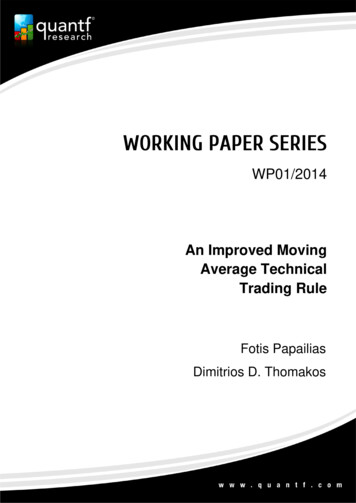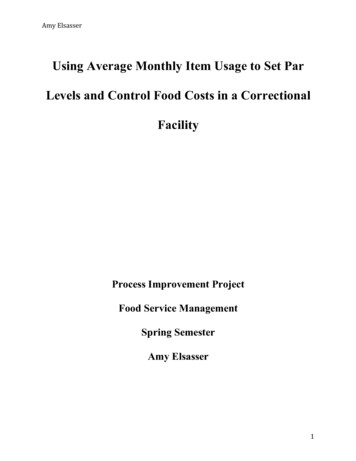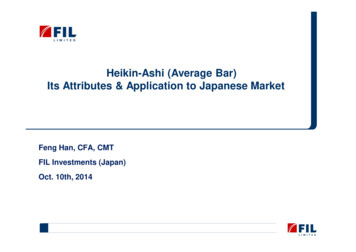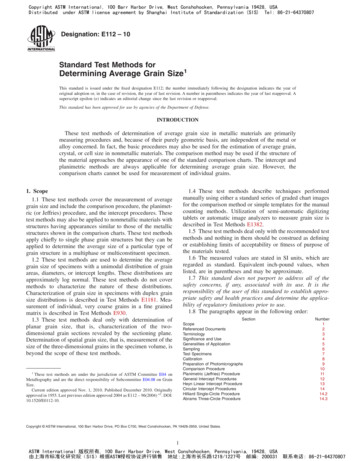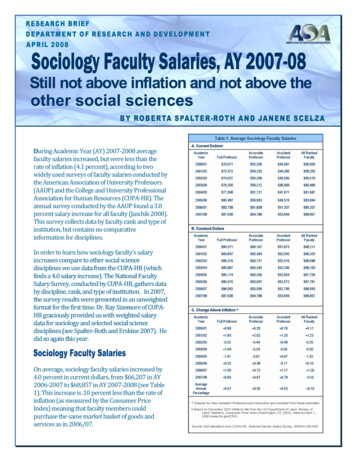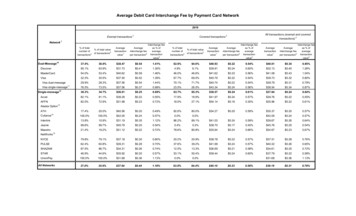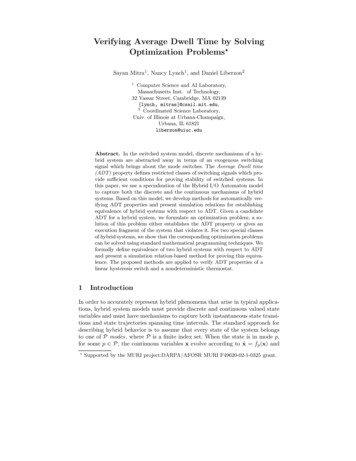
Transcription
Verifying Average Dwell Time by SolvingOptimization Problems?Sayan Mitra1 , Nancy Lynch1 , and Daniel Liberzon21Computer Science and AI Laboratory,Massachusetts Inst. of Technology,32 Vassar Street, Cambridge, MA 02139{lynch, mitras}@csail.mit.edu,2Coordinated Science Laboratory,Univ. of Illinois at Urbana-Champaign,Urbana, IL 61821liberzon@uiuc.eduAbstract. In the switched system model, discrete mechanisms of a hybrid system are abstracted away in terms of an exogenous switchingsignal which brings about the mode switches. The Average Dwell time(ADT) property defines restricted classes of switching signals which provide sufficient conditions for proving stability of switched systems. Inthis paper, we use a specialization of the Hybrid I/O Automaton modelto capture both the discrete and the continuous mechanisms of hybridsystems. Based on this model, we develop methods for automatically verifying ADT properties and present simulation relations for establishingequivalence of hybrid systems with respect to ADT. Given a candidateADT for a hybrid system, we formulate an optimization problem; a solution of this problem either establishes the ADT property or gives anexecution fragment of the system that violates it. For two special classesof hybrid systems, we show that the corresponding optimization problemscan be solved using standard mathematical programming techniques. Weformally define equivalence of two hybrid systems with respect to ADTand present a simulation relation-based method for proving this equivalence. The proposed methods are applied to verify ADT properties of alinear hysteresis switch and a nondeterministic thermostat.1IntroductionIn order to accurately represent hybrid phenomena that arise in typical applications, hybrid system models must provide discrete and continuous valued statevariables and must have mechanisms to capture both instantaneous state transitions and state trajectories spanning time intervals. The standard approach fordescribing hybrid behavior is to assume that every state of the system belongsto one of P modes, where P is a finite index set. When the state is in mode p,for some p P, the continuous variables x evolve according to ẋ fp (x) and?Supported by the MURI project:DARPA/AFOSR MURI F49620-02-1-0325 grant.
the discrete variables remain constant. Discrete transitions alter both continuousand discrete variables, which may lead to mode change. Analyzing the stabilityof hybrid systems is challenging because the stability of the continuous dynamics of each individual mode does not necessarily imply the stability of the wholesystem (see [2] for an example). The basic tool for studying stability of hybridsystems relies on the existence of a Common Lyapunov function, whose derivative along the trajectories of all the modes must satisfy suitable inequalities.When such a function is not known or does not exist, Multiple Lyapunov functions [2] are useful for proving stability of a chosen execution. These and manyother stability results are based on the switched system [9, 15] view of hybridsystems. Switched systems may be seen as higher-level abstractions of hybridsystems. A switched system model neglects the details of the discrete behaviorof a hybrid system and instead relies on an exogenous switching signal to bringabout the mode switches. If the individual modes of the system are stable, thenthe Dwell Time [14] and the more general Average Dwell Time (ADT) criteria, introduced by Morse and Hespanha [6], define restricted classes of switchingsignals that guarantee stability of the whole system. In this paper, we presenttechniques for automatically verifying ADT properties using a model for hybridsystems that captures both their discrete and continuous mechanisms. Thus weprovide a missing piece in the toolbox for analysis of stability of hybrid systems.We use the Hybrid Input/Output Automaton (HIOA) framework of Lynch,Segala, and Vaandrager [11] to develop methods for checking ADT properties,which in turn provide sufficient conditions for proving stability of hybrid systems. A hybrid system A has ADT τa if, in every execution fragment of A, anyτa interval of time, on an average, has at most one mode switch. A large ADTmeans that the system spends enough time in each mode to dissipate the transient energy gained through mode switches. Having a large ADT itself is notsufficient for stability; in addition, the individual modes of the automaton mustalso be stable. In fact, the problem of testing the stability of a hybrid system canbe broken down into (a) finding Lyapunov functions for the individual modesand (b) checking the ADT property. We assume that a solution to part (a)—a set of Lyapunov functions for the individual modes—is known from existingtechniques, and we present automatic methods for part (b).Our approach for checking if a given automaton A has ADT τa , is to formulatean optimization problem OPT(τa ). From the solution of OPT(τa ) we can eitherget a counterexample execution fragment of A that violates the ADT propertyτa , or else we can conclude that no such counterexample exists and that A hasADT τa . We show that for certain useful classes of HIOA, OPT(τa ) can indeedbe formulated and solved using standard mathematical programming techniques.In [12], an invariant-based method for proving ADT is proposed. This methodtransforms the given automaton A to a new automaton Aτa , so that A has ADTτa if and only if Aτa has a particular invariant property Iτa . This method isapplicable to any HIOA; however, for general HIOA, the invariant Iτa cannotbe checked automatically. The optimization-based approach presented here isautomatic and complements the invariant method of [12] because the two can be
used in combination to find the ADT of hybrid systems. We can start with somecandidate value of τa 0 and search for a counterexample execution fragmentfor it, using the optimization-based approach. If such an execution fragment isfound, then we decrease τa (say, by a factor of 2) and try again. If eventuallythe optimization approach fails to find a counterexample execution fragment fora particular value of τa , then we use the invariant approach to prove that thisvalue of τa is an ADT for the given system.Contributions and overview. In Section 2 we introduce a new model forhybrid systems called Structured Hybrid Automaton (SHA). We define stabilityand the Average Dwell Time (ADT) property of SHA. In Section 3 we introducethe optimization problem OPT(τa ), which searches for an execution fragment ofthe given SHA that violates the ADT property in question. We formally definewhat it means for one SHA to switch faster than another and for two SHA to beADT-equivalent. We define a new type of simulation relation, called switchingsimulation, that provides sufficient conditions for establishing the “faster than”and the equivalence relationships between SHA. In Section 4 we explore theclass of Graph SHA, for which solving OPT(τa ) reduces to detecting a negativecost cycle in a weighted graph. We verify the ADT property of a linear, scaleindependent hysteresis switch taken from [5] by first finding a Graph SHA Bthat is ADT-equivalent to it and then showing how OPT(τa ) for B can be solvedefficiently using standard graph algorithms, like the Bellman-Ford algorithm [3].In Section 5, we study a more general class of SHA, called Initialized SHA andshow that OPT(τa ) can be solved by detecting a cyclic execution fragment with“extra” mode switches. We show that for rectangular initialized SHA, OPT(τ a )can be formulated as a Mixed Integer Linear Program. We use this formulationalong with switching simulations to verify the ADT property of a nondeterministic thermostat.2Hybrid system model and stability definitionsThe Hybrid Input/Output Automaton (HIOA) model [11] with its invariant andsimulation based proof methods has been used to verify the safety properties ofseveral hybrid systems (see, e.g., [10, 13, 4]). In this paper, we are concerned withinternal stability of hybrid systems, so we use a specialization of the HIOA modelcalled Structured Hybrid Automata (SHA), that does not have input/outputvariables and does not distinguish among input, output, and internal actions.On the other hand, SHA have extra structure called “state models” for describingthe trajectories using differential and algebraic equations.2.1Structured Hybrid Automaton modelWe denote the domain of a function f by f.dom. For a set S f.dom, wewrite f d S for the restriction of f to S. If f is a function whose range is aset of functions containing Y , then we write f Y for the function g with
g.dom f.dom such that for each c g.dom, g(c) f (c) d Y . For a tuple or anarray b with n elements, we refer to its ith element by b[i].We fix the time axis T to be R 0 . Let X be a set of state variables; X ispartitioned into Xd , the set of discrete variables, and Xc , the set of continuousvariables. Each variable x X is associated with a type, which is the set ofvalues that x can assume. Each x Xd (respectively, Xc ) has dynamic type,which is the pasting closure of the set of constant (resp. continuous) functions3from left-closed intervals in T to the type of x. A valuation x for the set ofvariables X is a function that associates each x X to a value in its type. Theset of all valuations of X is denoted by val(X). A trajectory τ : J val(X)specifies the values of all variables X on a time interval J with left endpoint of Jequal to 0, with the constraint that evolution of each x X over the trajectoryshould be consistent with its dynamic type. A trajectory with domain [0, 0] iscalled a point trajectory. If τ.dom is right closed then τ is closed and its limittime is the supremum of τ.dom and is written as τ.ltime. The first valuationof τ , τ.f val is τ (0), and if τ is closed, then the last valuation of τ , τ.lval, isτ (τ.ltime).Definition 1. A state model F for a set of variables X is a set of differentialequations for Xc of the form ẋc f (xc ), such that: (1) For every x val(X),there exists a trajectory τ with τ.f val x, with the property that τ X c satisfiesF , and (2) for all t τ.dom, (τ Xd )(t) (τ Xd )(0). The prefix and suffixclosure of the set of trajectories of X that satisfy the above conditions is denotedby traj(X, F ).Definition 2. A Structured Hybrid Automaton (SHA) is a tuple A (X, Q, Θ,A, D, P ), where (1) X is a set of variables, including a special discrete variablecalled mode. (2) Q val(X) is the set of states, (3) Θ Q is a nonempty setof start states, (4) A is a set of actions, (5) D Q A Q is a set of discretetransitions, and (6) P is an indexed family Fi , i P, of state models, where Pis an index set.aaA transition (x, a, x0 ) D is written in short as x A x0 or as x x0 when Aais clear from the context. A transition x x0 is a mode switch if x d mode 6 0x d mode. The set of mode switching transitions is denoted by M . The guard apredicate of action a is Ga {x Q x0 , x x0 D}. In this paper,we assume that the right hand sides of the differential equations in the statemodels are well behaved (locally Lipschitz), and the differential equations havesolutions defined globally in time. Therefore, for each Fi , i P and x Q withx d mode i, there exists a trajectory τ starting from x that satisfies Fi andif, τ.dom is finite then τ.lval Ga for some a A. The set T of trajectories of SSHA A is defined as T i P traj(X, Fi ). An execution fragment of an SHA Ais an alternating sequence of actions and trajectories α τ0 a1 τ1 a2 . . ., where (1)ai 1each τi T , and (2) if τi is not the last trajectory then τi .lstate τi 1 .f state.3This set of functions must be closed under time-shift, restriction to subintervals, andpasting. See [7] for formal definition of these closure properties
The first state of an execution fragment α, α.f state, is τ0 .f state. An executionfragment α is an execution of A if α.f state Θ. The length of a finite executionfragment α is the number of actions in α. An execution fragment is closed if it isa finite sequence, and the domain of the last trajectory is closed. Given a closedexecution fragment α Pτ0 , a1 , . . . , τn , its last state, α.lstate, is τn .lstate and itslimit time is defined as ni τi .ltime. We define the following shorthand notationfor the valuation of the variables of A at t [0, α.ltime]: α(t) α0 .lstate, whereα0 is the longest prefix of α with α0 .ltime t. A state x Q is reachable if itis the last state of some execution of A. An execution fragment α is reachable ifα.f state is reachable. An invariant property or simply an invariant I of A is acondition on X that remains true in all reachable states of A. A closed executionfragment α of SHA A is a cycle if α.f state α.lstate.2.2Stability and Average Dwell TimeStability is a property of the continuous variables of SHA A with respect to thestandard Euclidean norm in Rn . At a given state x Q, we write the norm ofthe continuous variables x d Xc in short as x . We assume that for each i P,the origin is an equilibrium point for the state model ẋc fi (xc ) of A.SHA A is stable (also called stable in the sense of Lyapunov), if for every 0, there exists a δ 0, such that for every closed execution α of A, for allt [0, α.ltime], α(0) δ implies α(t) . A is asymptotically stable if it isstable and δ can be chosen so that, α(0) δ implies α(t) 0 as t . If theabove condition holds for all δ then A is globally asymptotically stable.Uniform stability guarantees that the stability property in question holdsfor execution fragments and not only for executions. A is uniformly stable iffor every 0 there exists a constant δ 0, such that for any executionfragment α, α.f state δ implies α.lstate . An SHA A is said to beuniformly asymptotically stable if it is uniformly stable and there exists a δ 0,such that for every 0 there exists a T , such that for any execution fragmentα with α.ltime T , t T , α.f state δ implies α(t) . It is saidto be globally uniformly asymptotically stable if the above holds for all δ, withT T (δ, ).It is well known that a hybrid system is stable if all the individual modes ofthe system are stable and the switching is sufficiently slow, so as to allow thedissipation of the transient effects after each switch. The dwell time [14] andthe average dwell time [6] criteria define restricted classes of switching patterns,based on switching speeds, and one can conclude the stability of a system withrespect to these restricted classes.Definition 3. Given a duration of time τa 0, SHA A has Average Dwell Time(ADT) τa if there exists a positive constant N0 , such that for every reachableexecution fragment α, N (α) N0 α.ltime/τa , where N (α) is the number ofmode switches in α. The number of extra switches of α with respect to τa is Sτa (α) N (α) α.ltime/τa .
Theorem 1 from [6], adapted to SHA, gives a sufficient condition for stabilitybased on ADT. Roughly, it states that a hybrid system is stable if the modes areindividually stable and the switches do not occur too frequently on the average.See Section 3.2 of [9] for a proof4 .Theorem 1. If there exist positive definite, radially unbounded, and continuously differentiable functions Vi : Rn Rn , for each i P, and positive numbersλ0 and µ such that: Vifi (xc ) λ0 Vi (xc ), xc xc , i P, andaVi (x0c ) µVj (xc ), x A x0 , where i x0 d mode and j x d mode.Then, A is globally uniformly asymptotically stable if it has an ADT τ a log µλ0 .This stability condition effectively allows us to decouple the construction ofLyapunov functions—the Vi ’s for each i P, which we assume are known fromavailable methods of system theory—from the problem of checking that theautomaton has a certain ADT, which we discuss in the rest of the paper.3ADT: Optimization and EquivalenceFrom Definition 3 it follows that a given τa 0 is not an ADT of a given SHA Aif and only if, for every N0 0 there exists a reachable execution fragment α ofA such that Sτa (α) N0 . Thus, if we solve the following optimization problem:OPT(τa ) :α arg max Sτa (α)over all the execution fragments of A, and the optimal value Sτa (α ) turns outto be bounded, then we can conclude that A has ADT τa , with Sτa (α ) as thecorresponding value of the constant N0 . Otherwise, if Sτa (α ) is unbounded andα is reachable then we can conclude that τa is not an ADT for A. However, theoptimization problem OPT(τa ) may not be solvable using standard mathematicalprogramming tools because, among other things, the executions of A may nothave any finite descriptions. In Sections 4 and 5 we study particular classes ofSHA for which OPT(τa ) can be solved, but prior to that we define what it meansfor two SHA to be ADT-equivalent and we develop a simulation relation-basedtechnique for proving this relationship.Definition 4. Consider SHA A and B. B is faster than A, written as B ADTA, if for all τa 0, τa is an ADT for B implies that τa is an ADT for A.If B ADT A and A ADT B, then A and B are ADT-equivalent, and this iswritten as A ADT B.4In [6] and [9] this theorem is presented for the case when discrete transitions do notchange the valuation of the continuous variables, but the same proof establishes theresult stated here.
Definition 5. A switching simulation relation from A to B is a relation R QA QB satisfying the following conditions:1. If x ΘA then there exists a y ΘB such that x R y.2. If x R y and α is an execution fragment of A consisting of a single actionsurrounded by two point trajectories with α.f state x, then B has a closedexecution fragment β, such that β.f state y, N (β) N (α), β.ltime 0,and α.lstate R β.lstate. Here N (β) is the number of mode switches in β.3. If x R y and α is an execution fragment of A consisting of a single closedtrajectory with α.f state x, then B has a closed execution fragment β, suchthat β.f state y, β.ltime α.ltime, and α.lstate R β.lstate.Lemma 1. Let R be a switching simulation relation from SHA A to B. Then,for all τa 0 and for every reachable execution fragment α of A, there exists areachable execution fragment β of B, such that Sτa (β) Sτa (α).Proof: We fix τa and α. Since α is reachable, there exists α0 such thatαα is an execution of A. Let α τ0 a1 τ1 a2 τ2 . . . and let α.f state x. Weconstruct execution β 0 β of B such that β, a reachable execution fragment,has more extra switches than α. Since α0 .f state Θ, we can find β 0 to besuch that α0 .f state R β 0 .f state and α0 .lstate R β 0 .lstate. Therefore, we havex R β.f state. Now, We consider cases for α to show that Sτa (β) Sτa (α):01. α is an infinite sequence.We can write α as an infinite concatenation α0 α1 α2 . . ., in which theexecution fragments αi with i even consist of a trajectory only, and theexecution fragments αi with i odd consist of a single discrete transitionsurrounded by two point trajectories.We define inductively a sequence β0 β1 β2 . . . of closed execution fragmentsof B such that for all i, βi .lstate βi 1 .f state, αi .lstate R βi .lstate, andSτa (β) Sτa (α). We use Property 3 of the definition of switching simulationfor the construction of the βi ’s with i even. This gives us βi .ltime αi .ltimefor every even i. We use Property 2 of the definition of switching simulationfor the construction of the βi ’s with i odd. This gives us βi .ltime αi .ltimeand N (βi ) N (αi ) for every odd i. Let β β0 β1 β2 . . ., which is clearlyan execution fragment for B. Since β.ltime α.ltime and N (β) N (α),the required property follows.2. α is a finite sequence ending with a closed trajectory.Similar to first case.3. α is a finite sequence ending with an open trajectory.Similar to first case, except that the final open trajectory of β is constructedusing Lemma 4.22 of [8].Theorem
cost cycle in a weighted graph. We verify the ADT property of a linear, scale-independent hysteresis switch taken from [5] by rst nding a Graph SHA B that is ADT-equivalent to it and then showing how OPT( a) for B can be solved e
